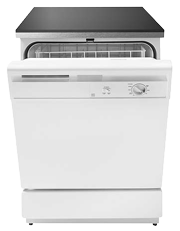Dishwasher Repair Guide
 For the DIY-inclined, the below guides will assist in completing simple repairs on your dishwasher. It is impossible to write guides applicable for every model of dishwasher, so in some cases there may be additional steps required to complete repairs.
For the DIY-inclined, the below guides will assist in completing simple repairs on your dishwasher. It is impossible to write guides applicable for every model of dishwasher, so in some cases there may be additional steps required to complete repairs.
DISCLAIMER: Appliance Repair can be dangerous, especially when dealing with electricity. The electrical current generated from wall outlets can be enough to kill someone. Please exercise extreme caution when working with appliances. GSAR cannot be held liable for injuries due to misuse of our repair guides.
How to Repair a Dishwasher That Won’t Drain
Sometimes the dishwasher drainage system will become obstructed causing the dishwasher not to drain properly. Common obstructions include coffee grounds, seeds, toothpicks, broken glass, bones, and chips off plates and coffee cups. Clearing out these obstructions will help to ensure that your pump does not become damaged.
Most dishwasher filtration systems can be easily accessed by appliance owners. If it is not accessible without special tools, there is a reason for this. Permanent damage can occur if repairs are completed incorrectly. If no special tools are required to access your filtration system, then it is safe to access the filter to look for broken glass shards or pieces of a broken dish. It’s a good idea to clean all accessible filters on a regular basis.
An obstructed AIRGAP can cause the dishwasher to not drain. California building code requires all residential and commercial dishwashers be installed with an AIRGAP.
What is an AIRGAP?
An AIRGAP is designed to prevent a cross contamination of waste water by avoiding direct physical contact. An AIRGAP provides a break between the potable water system, (the water we drink), and the waste or discharge sewer system. The two shall not make contact because bacteria may contaminate the drinking water. The AIRGAP provides a vacuum break which will not allow the back-flow of contaminated water in the drinking water system by providing air space between all potable and non-potable water systems.
The AIRGAP on a dishwasher serves multiple purposes. It allows water to backflow into the sink, relieving excessive pressure from a drain clog. It also acts as a vacuum break, preventing contaminated drain water from being sucked back into the dishwasher during its operation which many dishwashers may do during the drain cycle.

The following steps will show you how to check the dishwasher’s filtration system and how to access and clean your AIRGAP.
How to Check the Dishwasher Filtration System
- Open the door and remove the lower dish rack.
- The filtration system should be visible at the bottom of the dishwasher. If tools are not needed, there are usually arrows that provide directions to turn to remove and the filters. (This is especially common for Bosch and Miele dishwashers)
- Remove the filters and clean them in the sink using a small cleaning brush or old toothbrush and dish-soap.
- Replace the filters using the above steps in reverse.
- Ensure all filters are locked into place. Improper installation will cause your dishwasher to filter incorrectly.
Checking the Dishwasher AIRGAP System
- Pop the cap off the top of the AIRGAP. The AIRGAP cap is usually chrome, white, or copper in color. It should pop of with relative ease.
- Underneath the cap there will be another cap that is either unscrewed by hand or by two clips that must be depressed.
- Once the second cap has been removed, any obstructions should be plainly visible.
- Use tweezers or needle-nose pliers to remove obstructions from your AIRGAP.
- Replace caps in the order in which you removed.

